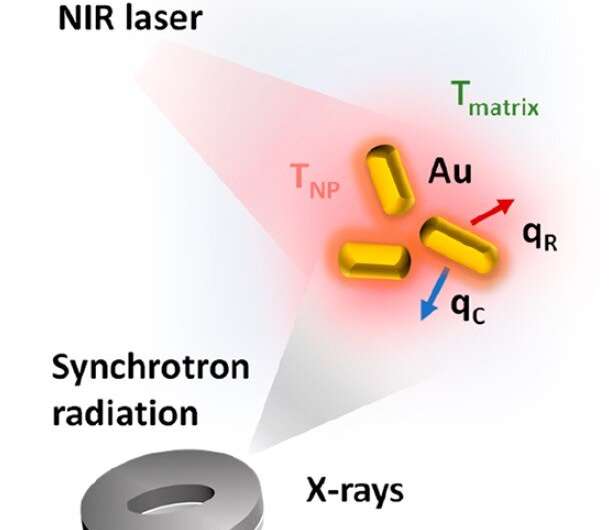Photothermal excitation of gold-based nanomaterials: the nanoparticle absorbs NIR (near infrared) light resulting in a localized heating. X-rays act as a probe of the local temperature. Credit: Nano Letters (ACS)
In hyperthermia treatments, the temperature is raised above physiological levels to induce the death of cancerous cells. The local application of hyperthermia is key for a successful treatment and to reduce damage to the healthy surrounding tissues. Going down to the nanoscale, nanoparticles can be used in hyperthermia treatments acting as nanoheaters and triggering cellular damage and/or inducing drug release in a selective manner.
The optimization of the heat capability of the nanoparticles is very important to better adjust the therapeutic thermal onset, since, in some cases, thermal healing effects may occur through local heating without a macroscopic temperature rise. Measuring the nanoscale details of the heating in the surrounding nanoparticles is challenging; so far, only indirect methods have been tested.
In their Nano Letters publication, a group of researchers led by Dr. Ana Espinosa (IMDEA Nanociencia) and Álvaro Muñoz-Noval (UCM) have proposed the measurement of the nanoscale heating of gold-based nanoparticles under hyperthermia conditions using X-ray absorption spectroscopy as an onsite and direct nanothermometric method. The results reveal significant nanothermal gradients—that is, high temperature variations within a small volume—and evidence a nanoscopic local temperature significantly higher than global temperature measurements. This method is versatile and allow measurement at the nanoscale for all types of particles and systems under hyperthermia exposure.
More information: Ana Espinosa et al. Photoactivated Nanoscale Temperature Gradient Detection Using X-ray Absorption Spectroscopy as a Direct Nanothermometry Method, Nano Letters (2020). DOI: 10.1021/acs.nanolett.0c04477
Journal information: Nano Letters
Provided by IMDEA Nanociencia























